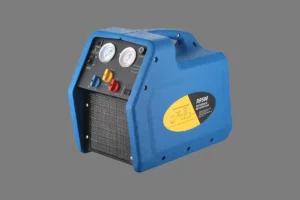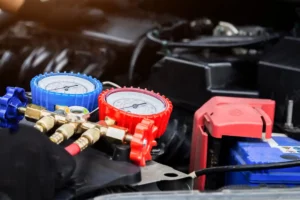Roots Vacuum Pump Systems achieve superior vacuum performance through integration. This includes high-quality Roots vacuum pumps and single-stage rotary vane pumps, or oil-sealed liquid ring pumps. The system elevates both the vacuum level and pumping speed, making them ideal for medium vacuum applications that demand high pumping rates.
Key Applications of Roots Vacuum Pump Systems
- Vacuum Metallurgy
- Advanced Vacuum Packaging
- Leak Detection Systems
- HVAC and Refrigeration Dehydration, and Drying Processes
- Primary Pump for a Molecular or Diffusion Pump in Coating Systems
The Synergy of Roots and Primary Pumps
To establish an efficient setup, the Roots Vacuum Pump (booster type) must be tandemly connected with a primary vacuum pump. This includes options like single-stage rotary vane pumps or a liquid ring pump.
This combined configuration empowers the Roots vacuum system to surpass the primary pump. It provides higher pumping speed and attains a lower ultimate pressure.
Choosing the Right Primary Pump
Choosing the right primary pump depends on several critical factors:
- Required pumping speed and ultimate pressure
- Properties of the pumped gas (condensable, flammable, corrosive, etc.)
- Cleanliness of the vacuum system
Understanding Pumping Speed Ratios
The ratio of pumping speed between Roots vacuum pumps and primary pumps hinges on two pivotal factors:
- The efficiency of the vacuum system
- Pressure differential at the inlet and outlet of the Roots pump
Roots Pump - Design in Efficiency
Roots pumps, featuring two symmetrical rotors, synchronize their rotation within the pump chamber. Their high speed and volumetric efficiency result in compact, lightweight pumps that offer flow rates ranging from 250 to 13,000 m3/h for equivalent volume. The gaps between rotors and chambers are relatively small (usually 0.15-1mm), allowing them to achieve lower pressures (in the medium vacuum range).
Importantly, no lubricating oil is present in the gas-pumping chamber, making Roots pumps well-suited for handling specialized gases in processes like chemical vacuum drying, distillation, and the semiconductor and electronics industries.
Key Formulas for Efficiency
- Theoretical Pumping Speed: STH = 4 × n × V (n: Rotor speed, V: Chamber volume when isolated from the inlet)
- Theoretical Flow Rate: Q PV,th = STH × (Pout – Pin)
- Actual Pumped Volume: qpv,eff = qpv,th – qpv,int,leak
Roots pump efficiency can be calculated as:
qpv,eff = K0 / (K0 + Sratio – 1)
Where:
- Sratio: The ratio of Roots pump to primary pump pumping speeds
When Sratio = 1, Roots pump efficiency equals 1. Higher Sratio values result in lower efficiency. When K0 exceeds 20 and the ratio is less than 10, Roots pump efficiency can surpass 70%, which is generally considered an acceptable lower limit for efficiency.
Achieving Ultimate Pressure
The ultimate pressure of a Roots vacuum system is typically achieved by dividing the primary pump’s pressure by the compression ratio. In practice, this value is further multiplied by 3 – 5.
For instance, using a single-stage rotary vane pump as the primary pump theoretically results in an ultimate pressure of 50 Pa / 35 = 1.4 Pa. However, the practical ultimate pressure usually achieved is around 5 Pa. When using a liquid ring pump as the primary pump, the theoretical ultimate pressure is 3300 Pa / 15 = 220 Pa, with a practical ultimate pressure typically reaching 660 Pa.
Preventing Overheating and Overload
To prevent overheating and overload, Roots pumps without overflow valves or other protective devices should only be started after the primary pump reaches a certain pressure, calculated as:
P switch on = Maximum pressure difference / (Efficiency × Pumping speed ratio – 1)
The outlet temperature of Roots pumps can be calculated as:
Tout = Tin × (Pout / Pin)^(1/6)
In Conclusion
- In general, Roots vacuum pumps with zero-flow compression ratios greater than 20 at exhaust pressures of 10-2000 Pa are most effective in improving vacuum levels. Selecting a primary pump with an ultimate pressure of 10-2000 Pa, such as a single-stage oil-sealed rotary vane pump, and an oil-sealed liquid ring vacuum system, can raise the system’s vacuum level by more than one order of magnitude.
- For higher vacuum levels, primary pumps like two-stage rotary vane pumps can have larger pumping speed ratios, ideally around 10. For lower vacuum levels, primary pumps like liquid ring pumps typically have lower pumping speed ratios, or even a ratio of 1 for improved vacuum and prevention of cavitation.
- Vacuum systems with three or more stages of Roots pumps can achieve ultimate pressures as low as 0.01 Pa.
- To prevent overload or overheating of Roots pumps, it is advisable to let the primary pump run first and reach the starting pressure before activating the Roots pump. Alternatively, Roots pumps should be equipped with overflow valves or magnetic fluid couplings as overload protection. In the case of Roots pumps with these protection mechanisms, a slight delay in starting the Roots pump is also recommended for noise reduction and other considerations.
- Coolink: TOP 3 Global HVAC Vacuum Pump Manufacturer
- Elitevak: Quality Industrial Vacuum Pump Supplier from China






